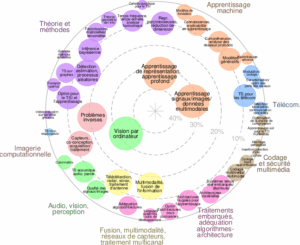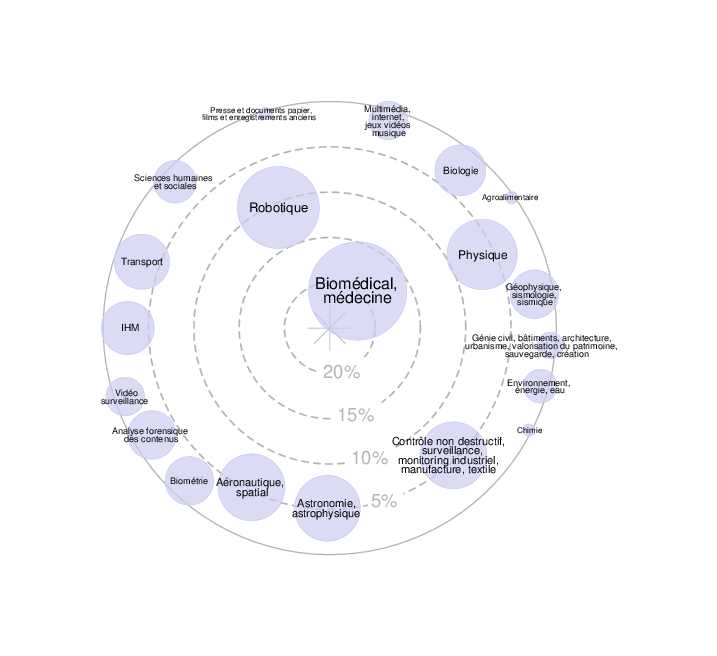Duration: 6 months
Start date: From February 2026
Level: Master’s degree (M2 or equivalent) in Applied Mathematics, Signal or Image Processing
Allowance: According to current French regulations (approximately €630/month)
Location: IRIMAS Institute – IMTIS team, University of Haute-Alsace, Mulhouse, France
Keywords: time–frequency analysis, frame theory, optimization, off-grid sparsity
Context and Objectives
This internship focuses on the time–frequency analysis of non-stationary signals.
The main objective is to explore new methodological approaches to improve the readability of linear time–frequency representations.
Classical methods, apart from post-processing techniques such as synchrosqueezing [1], suffer from certain limitations: they often rely on global criteria applied over the entire time–frequency plane, which limits their ability to adapt locally to variations in the signal components. Moreover, the criteria used in optimization formulations are generally based on statistical measures of energy concentration (such as Rényi entropy), which do not always capture the structural complexity of the signal.
Proposed Work
In this context, several complementary research directions may be explored during the internship, depending on the progress of the work:
- Local optimization of energy concentration, by adapting the analysis window parameters in specific regions of the time–frequency plane: for example, in areas with strong interference [2].
- Definition of new optimization criteria, integrating information from the phase and zeros in the time–frequency plane, which can provide additional insights into the signal structure [3–5].
- Formulation of time–frequency transforms within the framework of frame theory [6], which generalizes orthonormal bases. In this setting, improving readability may be expressed as a sparse optimization problem, potentially addressed using an off-grid approach [7].
Candidate Profile
- Master’s student (M2) or final-year engineering student with a specialization in Applied Mathematics, Signal Processing, or Image Processing.
- A strong interest in research in signal processing is expected.
- Proficiency in Python and/or MATLAB is required.
- Knowledge of time–frequency analysis and frame theory is an appreciated asset.
Perspectives
This internship may be followed by a PhD thesis within the ANR TIPHAINE project (Time–Frequency Analysis of Interference in Complex Signals), in collaboration with the Laboratoire Jean Kuntzmann (LJK) in Grenoble and the Laboratoire de Physique at the École Normale Supérieure de Lyon.
Application
Please send a CV, a cover letter, and your latest academic transcript to: ali.moukadem@uha.fr
References
[1] Daubechies, Ingrid, Jianfeng Lu, and Hau-Tieng Wu. Synchrosqueezed wavelet transforms: An empirical mode decomposition-like tool. Applied and computational harmonic analysis 30.2 (2011): 243-261.
[2] Meignen, Sylvain, and Marcelo A. Colominas. A new ridge detector localizing strong interference in multicomponent signals in the time-frequency plane. IEEE Transactions on Signal Processing 71 (2023): 3413-3425.
[3] Miramont, Juan M., Auger, François, Colominas, Marcelo. Unsupervised classification of the spectrogram zeros with an application to signal detection and denoising. Signal Processing 214 (2024): 109250.
[4] Flandrin, Patrick. Time–frequency filtering based on spectrogram zeros. IEEE Signal Processing Letters, 2015, vol. 22, no 11, p. 2137-2141.
[5] Moukadem, Ali, Pascal, Barbara, Courbot, Jean-Baptiste, Juillet, Nicolas. The analytic Stockwell transform and its zeros. Chaos, Solitons & Fractals, 2025, vol. 197, p. 116439.
[6] Gröchenig, Karlheinz. Foundations of time-frequency analysis. Springer Science & Business Media, 2001.
[7] Kusano, Tsubasa, Yatabe, Kohei, et Oikawa, Yasuhiro. Sparse time-frequency representation via atomic norm minimization. In : ICASSP 2021-2021 IEEE International Conference on Acoustics, Speech and Signal Processing (ICASSP). IEEE, 2021. p. 5075-5079.





